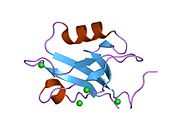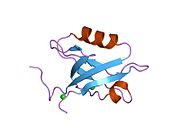Sodium-hydrogen antiporter 3 regulator 1
Sodium-hydrogen antiporter 3 regulator 1 is a regulator of Sodium-hydrogen antiporter 3. It is encoded by the gene SLC9A3R1. It is also known as ERM Binding Protein 50 (EBP50) or Na+/H+ Exchanger Regulatory Factor (NHERF1). It is believed[5] to interact via long-range allostery, involving significant protein dynamics.
Mechanism
[edit]Members of the ezrin (VIL2; MIM 123900)-radixin (RDX; MIM 179410)-moesin (MSN; MIM 309845) (ERM) protein family are highly concentrated in the apical aspect of polarized epithelial cells. These cells are studded with microvilli containing bundles of actin filaments, which must attach to the membrane to assemble and maintain the microvilli. The ERM proteins, together with merlin, the NF2 (MIM 607379) gene product, are thought to be linkers between integral membrane and cytoskeletal proteins, and they bind directly to actin in vitro. Actin cytoskeleton reorganization requires the activation of a sodium/hydrogen exchanger (SLC9A3; MIM 182307). SLC9A3R1 is an ERM-binding protein.[supplied by OMIM][6]
Interactions
[edit]Sodium-hydrogen antiporter 3 regulator 1 has been shown to interact with:
See also
[edit]- Cystic fibrosis transmembrane conductance regulator
- Ezrin
- Moesin
- Neutron spin echo
- Radixin
- Solute carrier family
References
[edit]- ^ a b c GRCh38: Ensembl release 89: ENSG00000109062 – Ensembl, May 2017
- ^ a b c GRCm38: Ensembl release 89: ENSMUSG00000020733 – Ensembl, May 2017
- ^ "Human PubMed Reference:". National Center for Biotechnology Information, U.S. National Library of Medicine.
- ^ "Mouse PubMed Reference:". National Center for Biotechnology Information, U.S. National Library of Medicine.
- ^ Farago B, Li J, Cornilescu G, Callaway DJ, Bu Z (November 2010). "Activation of nanoscale allosteric protein domain motion revealed by neutron spin echo spectroscopy". Biophys. J. 99 (10): 3473–82. Bibcode:2010BpJ....99.3473F. doi:10.1016/j.bpj.2010.09.058. PMC 2980739. PMID 21081097.
- ^ "Entrez Gene: SLC9A3R1 solute carrier family 9 (sodium/hydrogen exchanger), member 3 regulator 1".
- ^ Karthikeyan S, Leung T, Ladias JA (May 2002). "Structural determinants of the Na+/H+ exchanger regulatory factor interaction with the beta 2 adrenergic and platelet-derived growth factor receptors". J. Biol. Chem. 277 (21): 18973–8. doi:10.1074/jbc.M201507200. PMID 11882663.
- ^ a b Hall RA, Ostedgaard LS, Premont RT, Blitzer JT, Rahman N, Welsh MJ, Lefkowitz RJ (July 1998). "A C-terminal motif found in the beta2-adrenergic receptor, P2Y1 receptor and cystic fibrosis transmembrane conductance regulator determines binding to the Na+/H+ exchanger regulatory factor family of PDZ proteins". Proc. Natl. Acad. Sci. U.S.A. 95 (15): 8496–501. Bibcode:1998PNAS...95.8496H. doi:10.1073/pnas.95.15.8496. PMC 21104. PMID 9671706.
- ^ Hall RA, Premont RT, Chow CW, Blitzer JT, Pitcher JA, Claing A, Stoffel RH, Barak LS, Shenolikar S, Weinman EJ, Grinstein S, Lefkowitz RJ (April 1998). "The beta2-adrenergic receptor interacts with the Na+/H+-exchanger regulatory factor to control Na+/H+ exchange". Nature. 392 (6676): 626–30. Bibcode:1998Natur.392..626H. doi:10.1038/33458. PMID 9560162. S2CID 4422540.
- ^ Shibata T, Chuma M, Kokubu A, Sakamoto M, Hirohashi S (July 2003). "EBP50, a beta-catenin-associating protein, enhances Wnt signaling and is over-expressed in hepatocellular carcinoma". Hepatology. 38 (1): 178–86. doi:10.1053/jhep.2003.50270. PMID 12830000. S2CID 10325091.
- ^ a b Park M, Ko SB, Choi JY, Muallem G, Thomas PJ, Pushkin A, Lee MS, Kim JY, Lee MG, Muallem S, Kurtz I (Dec 2002). "The cystic fibrosis transmembrane conductance regulator interacts with and regulates the activity of the HCO3- salvage transporter human Na+-HCO3- cotransport isoform 3". J. Biol. Chem. 277 (52): 50503–9. doi:10.1074/jbc.M201862200. PMID 12403779.
- ^ Hegedüs T, Sessler T, Scott R, Thelin W, Bakos E, Váradi A, Szabó K, Homolya L, Milgram SL, Sarkadi B (March 2003). "C-terminal phosphorylation of MRP2 modulates its interaction with PDZ proteins". Biochem. Biophys. Res. Commun. 302 (3): 454–61. doi:10.1016/S0006-291X(03)00196-7. PMID 12615054.
- ^ Wang S, Raab RW, Schatz PJ, Guggino WB, Li M (May 1998). "Peptide binding consensus of the NHE-RF-PDZ1 domain matches the C-terminal sequence of cystic fibrosis transmembrane conductance regulator (CFTR)". FEBS Lett. 427 (1): 103–8. doi:10.1016/S0014-5793(98)00402-5. PMID 9613608. S2CID 20803242.
- ^ Moyer BD, Duhaime M, Shaw C, Denton J, Reynolds D, Karlson KH, Pfeiffer J, Wang S, Mickle JE, Milewski M, Cutting GR, Guggino WB, Li M, Stanton BA (September 2000). "The PDZ-interacting domain of cystic fibrosis transmembrane conductance regulator is required for functional expression in the apical plasma membrane". J. Biol. Chem. 275 (35): 27069–74. doi:10.1074/jbc.M004951200. PMID 10852925.
- ^ Gentzsch M, Cui L, Mengos A, Chang XB, Chen JH, Riordan JR (February 2003). "The PDZ-binding chloride channel ClC-3B localizes to the Golgi and associates with cystic fibrosis transmembrane conductance regulator-interacting PDZ proteins". J. Biol. Chem. 278 (8): 6440–9. doi:10.1074/jbc.M211050200. PMID 12471024.
- ^ Short DB, Trotter KW, Reczek D, Kreda SM, Bretscher A, Boucher RC, Stutts MJ, Milgram SL (July 1998). "An apical PDZ protein anchors the cystic fibrosis transmembrane conductance regulator to the cytoskeleton". J. Biol. Chem. 273 (31): 19797–801. doi:10.1074/jbc.273.31.19797. PMID 9677412.
- ^ Rochdi MD, Watier V, La Madeleine C, Nakata H, Kozasa T, Parent JL (October 2002). "Regulation of GTP-binding protein alpha q (Galpha q) signaling by the ezrin-radixin-moesin-binding phosphoprotein-50 (EBP50)". J. Biol. Chem. 277 (43): 40751–9. doi:10.1074/jbc.M207910200. PMID 12193606.
- ^ Huang P, Steplock D, Weinman EJ, Hall RA, Ding Z, Li J, Wang Y, Liu-Chen LY (June 2004). "kappa Opioid receptor interacts with Na(+)/H(+)-exchanger regulatory factor-1/Ezrin-radixin-moesin-binding phosphoprotein-50 (NHERF-1/EBP50) to stimulate Na(+)/H(+) exchange independent of G(i)/G(o) proteins". J. Biol. Chem. 279 (24): 25002–9. doi:10.1074/jbc.M313366200. PMID 15070904.
- ^ Li JG, Chen C, Liu-Chen LY (July 2002). "Ezrin-radixin-moesin-binding phosphoprotein-50/Na+/H+ exchanger regulatory factor (EBP50/NHERF) blocks U50,488H-induced down-regulation of the human kappa opioid receptor by enhancing its recycling rate". J. Biol. Chem. 277 (30): 27545–52. doi:10.1074/jbc.M200058200. PMID 12004055.
- ^ a b Brdicková N, Brdicka T, Andera L, Spicka J, Angelisová P, Milgram SL, Horejsí V (October 2001). "Interaction between two adapter proteins, PAG and EBP50: a possible link between membrane rafts and actin cytoskeleton". FEBS Lett. 507 (2): 133–6. doi:10.1016/S0014-5793(01)02955-6. PMID 11684085. S2CID 12676563.
- ^ a b Maudsley S, Zamah AM, Rahman N, Blitzer JT, Luttrell LM, Lefkowitz RJ, Hall RA (November 2000). "Platelet-derived growth factor receptor association with Na(+)/H(+) exchanger regulatory factor potentiates receptor activity". Mol. Cell. Biol. 20 (22): 8352–63. doi:10.1128/MCB.20.22.8352-8363.2000. PMC 102142. PMID 11046132.
- ^ Gisler SM, Pribanic S, Bacic D, Forrer P, Gantenbein A, Sabourin LA, Tsuji A, Zhao ZS, Manser E, Biber J, Murer H (November 2003). "PDZK1: I. a major scaffolder in brush borders of proximal tubular cells". Kidney Int. 64 (5): 1733–45. doi:10.1046/j.1523-1755.2003.00266.x. PMID 14531806.
- ^ Mahon MJ, Donowitz M, Yun CC, Segre GV (June 2002). "Na(+)/H(+ ) exchanger regulatory factor 2 directs parathyroid hormone 1 receptor signalling". Nature. 417 (6891): 858–61. Bibcode:2002Natur.417..858M. doi:10.1038/nature00816. PMID 12075354. S2CID 4379134.
- ^ Pushkin A, Abuladze N, Newman D, Muronets V, Sassani P, Tatishchev S, Kurtz I (March 2003). "The COOH termini of NBC3 and the 56-kDa H+-ATPase subunit are PDZ motifs involved in their interaction". Am. J. Physiol., Cell Physiol. 284 (3): C667–73. doi:10.1152/ajpcell.00225.2002. PMID 12444018. S2CID 7070088.
- ^ Mohler PJ, Kreda SM, Boucher RC, Sudol M, Stutts MJ, Milgram SL (November 1999). "Yes-associated protein 65 localizes p62(c-Yes) to the apical compartment of airway epithelia by association with EBP50". J. Cell Biol. 147 (4): 879–90. doi:10.1083/jcb.147.4.879. PMC 2156157. PMID 10562288.
- ^ Reczek D, Berryman M, Bretscher A (October 1997). "Identification of EBP50: A PDZ-containing phosphoprotein that associates with members of the ezrin-radixin-moesin family". J. Cell Biol. 139 (1): 169–79. doi:10.1083/jcb.139.1.169. PMC 2139813. PMID 9314537.
Further reading
[edit]- Weinman EJ, Steplock D, Wang Y, Shenolikar S (1995). "Characterization of a protein cofactor that mediates protein kinase A regulation of the renal brush border membrane Na(+)-H+ exchanger". J. Clin. Invest. 95 (5): 2143–9. doi:10.1172/JCI117903. PMC 295815. PMID 7738182.
- Yun CH, Oh S, Zizak M, et al. (1997). "cAMP-mediated inhibition of the epithelial brush border Na+/H+ exchanger, NHE3, requires an associated regulatory protein". Proc. Natl. Acad. Sci. U.S.A. 94 (7): 3010–5. Bibcode:1997PNAS...94.3010Y. doi:10.1073/pnas.94.7.3010. PMC 20313. PMID 9096337.
- Murthy A, Gonzalez-Agosti C, Cordero E, et al. (1998). "NHE-RF, a regulatory cofactor for Na(+)-H+ exchange, is a common interactor for merlin and ERM (MERM) proteins". J. Biol. Chem. 273 (3): 1273–6. doi:10.1074/jbc.273.3.1273. PMID 9430655.
- Hall RA, Spurney RF, Premont RT, et al. (1999). "G protein-coupled receptor kinase 6A phosphorylates the Na(+)/H(+) exchanger regulatory factor via a PDZ domain-mediated interaction". J. Biol. Chem. 274 (34): 24328–34. doi:10.1074/jbc.274.34.24328. PMID 10446210.
- Cao TT, Deacon HW, Reczek D, et al. (1999). "A kinase-regulated PDZ-domain interaction controls endocytic sorting of the beta2-adrenergic receptor". Nature. 401 (6750): 286–90. Bibcode:1999Natur.401..286C. doi:10.1038/45816. PMID 10499588. S2CID 4386883.
- Breton S, Wiederhold T, Marshansky V, et al. (2000). "The B1 subunit of the H+ATPase is a PDZ domain-binding protein. Colocalization with NHE-RF in renal B-intercalated cells". J. Biol. Chem. 275 (24): 18219–24. doi:10.1074/jbc.M909857199. PMID 10748165.
- Tang Y, Tang J, Chen Z, et al. (2001). "Association of mammalian trp4 and phospholipase C isozymes with a PDZ domain-containing protein, NHERF". J. Biol. Chem. 275 (48): 37559–64. doi:10.1074/jbc.M006635200. PMID 10980202.
- Gisler SM, Stagljar I, Traebert M, et al. (2001). "Interaction of the type IIa Na/Pi cotransporter with PDZ proteins". J. Biol. Chem. 276 (12): 9206–13. doi:10.1074/jbc.M008745200. PMID 11099500.
- Reczek D, Bretscher A (2001). "Identification of Epi64, a Tbc/Rabgap Domain–Containing Microvillar Protein That Binds to the First PDZ Domain of Ebp50 and E3karp". J. Cell Biol. 153 (1): 191–206. doi:10.1083/jcb.153.1.191. PMC 2185518. PMID 11285285.
- Karthikeyan S, Leung T, Ladias JA (2001). "Structural basis of the Na+/H+ exchanger regulatory factor PDZ1 interaction with the carboxyl-terminal region of the cystic fibrosis transmembrane conductance regulator". J. Biol. Chem. 276 (23): 19683–6. doi:10.1074/jbc.C100154200. PMID 11304524.
- Karthikeyan S, Leung T, Birrane G, et al. (2001). "Crystal structure of the PDZ1 domain of human Na(+)/H(+) exchanger regulatory factor provides insights into the mechanism of carboxyl-terminal leucine recognition by class I PDZ domains". J. Mol. Biol. 308 (5): 963–73. doi:10.1006/jmbi.2001.4634. PMID 11352585.
This article incorporates text from the United States National Library of Medicine, which is in the public domain.












